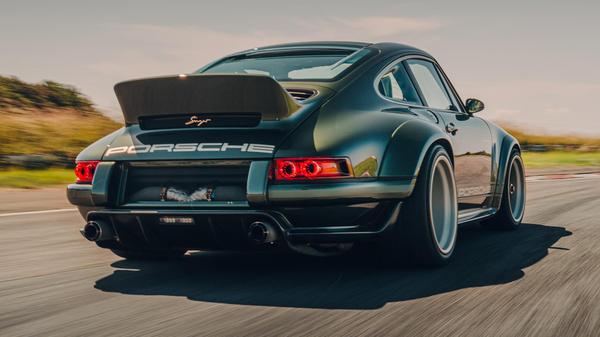At its heart the chassis and subframes are the same. But the DLS is 60 per cent stiffer. Not only has a 40mm FIA roll cage been (mostly) hidden in there, but the carbon fibre body panels are structural, adding rigidity. And Singer has arrived at the same front axle solution as Porsche themselves.
This, like the latest GT3, features double wishbone front suspension, improving turn-in, grip and precision – handy when the rear axle is a fulcrum, with the engine behind levering the front up. Something Singer has managed to combat: by reducing the gearbox casing it’s been able to shunt the engine forwards a couple of inches. Here’s another telling detail: the dampers are from Exe-TC, the same firm that supported Seb Loeb for most of his WRC championships, which is indicative of how Singer envisages this car. It’s not a locked down racer, but is designed to be usable, comfortable.
And then there’s the aero. The whole car has been subjected to a full CFD (Computational Fluid Dynamics) program. Apparently bar a bit of added stability, the ducktail spoiler on the back of the famous 1973 Carrera RS didn’t really do much. In order to make it properly effective the roofline has been dropped 20mm. It’s disguised by a slender bridge spoiler which also serves to channel air down the plexiglass back screen and on to a ducktail that is 22mm taller, more upright and has a built in 5mm gurney flap. That’s balanced out by a front splitter and clever underbody aero.
I could go on – the lengths that have been gone to here are ridiculous. But look at it this way. The diligence and care with which Singer has always handled the 964's cosmetics, the truth contained in ‘reimagined’, has now been applied to the engineering. In the words of Singer’s founder Rob Dickinson the plan was “no holds barred, how great can an old air-cooled 911 be?”.
And what’s the answer?
Utterly magnificent. From start to finish, it’s endlessly absorbing, emphatically not a car that needs to be going fast to be appreciated. The process of snicking a gear in the Hewland six-speed manual. Of lifting the hefty clutch and getting rolling. Of feeling the way the rally-spec dampers cushion the road yet communicate the surface texture. Of letting the engine start to climb. You get all this and more at low speed, it’s an indulgence from first to last.

But the really clever stuff happens when you’re going faster. Open the taps in third, and the response is so instant, so impactful in a car weighing so little, that it’s an overload the first few times. Everything happens simultaneously: induction air is gulped down, the rear squats, the seat pushes into you, the speed starts climbing. Stick with it and the noise, almost all induction rather than exhaust, becomes the main event. It is glorious. So present, unfiltered and yet tuneful, so motorsport. It feels, sounds and behaves like a race engine. The revs rise and fall in an instant, yet somehow every heel ‘n’ toe downshift is perfect. I did at one stage check if there was a rev blip backing up my footwork. There wasn’t, the pedals just make it easy.
Weighing less than 1,100kg (down near 1,000kg if you do without the noselift, air con and subwoofers of this car) the DLS is very, very fast, but beyond Williams’ calculations that it’ll do about 210mph, Singer has no idea what the acceleration might be. It’s irrelevant. They know it’s fast and for a car that’s intended to celebrate driving, that’s enough.
Likewise, it doesn’t seek to fix the 964's handling traits, so much as make them more reassuring and flattering. Lift off as you turn in and the tail moves quickly but progressively. That famous characteristic is present and correct, but now you have a choice. With the super accurate throttle you can choose to exploit that, in which case you’ll discover the DLS’s chassis has a drift sweet spot a mile wide. Or you can work both axles more evenly, in which case what’ll surprise you is just how confident you feel in the front end and how nice it is to have steering with actual feel and linear behaviour that isn’t super sharp just off centre.
Go in to a second gear corner on a balanced throttle, nail it and it will be the front wheels that yield first, skating into understeer, but that’s what an old 911 is all about – understanding the dynamics and balance of the car and then getting the best from it. The CCM-R Brembo brakes are amazingly potent, its performance and speed and grip are bang up to date, but the underlying chassis traits are 30 years old.
And that’s a drawback, right?
No, there’s nothing wrong with that. It’s not as clean and honed and ruthless as a modern supercar or hypercar, but it demonstrates (as so many restomods do) why we love cars like this. It’s not locked in a numbers battle that has so little relevance to the actual experience of driving. Instead this is an old 911 living its best life.









